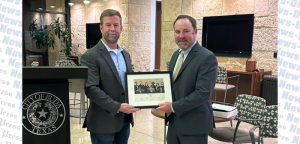By Andy Sevilla
A place where students can succeed.
That’s how Sylvia Villejo, principal at the Impact Center, describes her campus and instruction, which serves as Hays CISD’s Discipline Alternative Education Program (DAEP).
Villejo says on the Impact Center website that building relationships with students and parents can create an atmosphere where students may thrive.
“The one thing we really need to pursue at the Impact [Center] is mentors,” Villejo told the Hays CISD school board at an Oct. 20 meeting. “…One parent asked me for one today. I think it makes a big difference.”
For some students, lack of involvement with school or extra-curricular activities, lax structure or family issues at home can lead them to behave in a manner that ultimately transitions them to the Impact Center, Villejo said. And that’s where a little added help can come into play.
“Mentoring can make all the difference in the world,” school board vice president Holly Raymond said.
While many Hays CISD students of different backgrounds, races and socioeconomic statuses walk through the doors of the Impact Center, it is ninth and tenth grade Hispanic males who largely make up the campus, according to enrollment statistics.
Villejo said, in any given year, between 77 and 79 percent of students enrolled at the Impact Center are Hispanic males. That figure is not consistent with the demographics of the school district, which only has 62 percent Hispanic students enrolled district-wide, according to July 2013 Hays CISD statistics.
Forty six percent of students in the district are economically disadvantaged and 16 percent of students have limited English proficiency, the statistics reveal.
“I believe in Impact,” Trustee Sandra Bryant told Villejo at the meeting. “I have visited your campus several times and I do like the structure that you provide students. I’m wondering if the ninth and tenth graders, which you said are the highest number [of students enrolled], are just having a problem with transitioning to high school and that’s where counselors and others play a role.”
With the school board’s support of ninth grade centers, enrollment at the Impact Center has lessened, Villejo said, adding that ninth graders at the campus are in fewer numbers than in the past.
Still, ninth grade students made up 20 percent of the campus’ enrollment in the 2013-14 school year, only topped by tenth graders who accounted for 23 percent.
Raymond, who works for Big Brothers Big Sisters of Central Texas, said mentorships is a positive way to impact students.
“I know that we are working with the Seedling Foundation at Ralph Pfluger Elementary, and they focus on mentoring and they have some pretty strict requirements about that,” Raymond said. “I would be curious if that wasn’t something that they could do to help Impact [Center] students.”
Offenses ranging from misbehaving and graffiti to drugs and weapons can land students at the Impact Center. Officials say some of the consequences have mandatory placement based on the Texas Education Code. Other times, secondary administrators work with district staff to discuss other disciplinary actions before placement to Impact Center.







